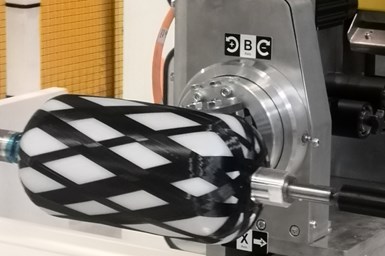NCC commissions Cygnet Texkimp filament winder for hydrogen development
Multifunctional four-axis winding system offering fiber flexibility will underpin the NCC’s work in testing and manufacturing pressure vessels leading to commercial production.
Composites technology company Cygnet Texkimp (Northwich, U.K.) has delivered a four-axis filament winding machine to the National Composites Centre (NCC, Bristol, U.K.) where it will form part of a new state-of-the-art manufacturing and test facility for hydrogen transportation and storage.
The multifunctional filament winding technology has been developed by Cygnet Texkimp to provide the NCC and its partners with the capability to wind all types of filaments — from towpregs to dry fiber and glass fiber — and all combinations of fibers and resins including high-viscosity and fast-cure resins.
“We’re proud to see our filament winding technology forming part of the NCC’s world-leading Hydrogen Program,” Cygnet Texkimp CEO Luke Vardy notes. “The work of the NCC and its partners stands at the forefront of an exciting new era of hydrogen tank design and development and plays an important role in anchoring this area of manufacture in the U.K.”
Learn more about Cygnet Texkimp’s equipment’s role in hydrogen applications, “Manufacturing tech for scalable Type V hydrogen tank fabrication, CFRP lifecycle management”
According to Marcus Walls-Bruck, head of hydrogen at the NCC, this acquisition “builds on our investment in capability development for hydrogen, with this machine predominantly focused at pressure vessels.” Moreover, “it will help the U.K. create supply chains to achieve its net-zero ambitions. A key technology that underpins our state-of-the-art design, test and manufacturing facility for hydrogen, it will be used to create pressure vessels for a number of applications, with this capability supporting industry in developing business cases and products to enter this growing market.”
The filament winder is designed to wind four tows simultaneously. Each tow has its own tension control unit and dancer arm which regulates feeding and winding tension to enable faster and more accurate winding. A customized software package, developed by Cygnet Texkimp’s in-house team, also enables the NCC to record data including winding tension and speed, resin temperature and air pressure within the mandrel.
The filament winder is served by two four-position creels that are designed to feed different types of fiber into the process. A towpreg creel unwinds and guides towpreg material into the winder and is an essential part of a novel solution designed to completely isolate the tension required at the bobbin from the tension desired during the winding phase, in order to ensure that the fiber is fed optimally at all times. A second dry fiber creel feeds fibers into the process at low tension and high accuracy and is enclosed to prevent the release of airborne debris into the environment.
The machine also features two types of in-line spreading and coating capability which can be quickly and easily deployed for dry-wind applications: a temperature-controlled wetout system with adjustable spreader bars to spread individual fiber tows for consistent resin impregnation; and a coating drum and blade to control the volume of resin applied to the fiber. Both of these methodologies will be investigated by the NCC for their suitability in winding applications across a range of applications.
Related Content
-
Composites end markets: Aerospace (2023)
With COVID in the past and passengers flying again, commercial aircraft production is ramping up. The aerocomposites supply chain is busy developing new M&P for an approaching next-generation aircraft program.
-
Composites opportunities in eVTOLs
As eVTOL OEMs seek to advance program certification, production scale-up and lightweighting, AAM’s penetration into the composites market is moving on an upward trajectory.
-
JEC World 2022, Part 1: Highlights in sustainable, digital, industrialized composites
JEC World 2022 offered numerous new developments in composites materials, processes and applications, according to CW senior editor, Ginger Gardiner, most targeting improved sustainability for wider applications.
















